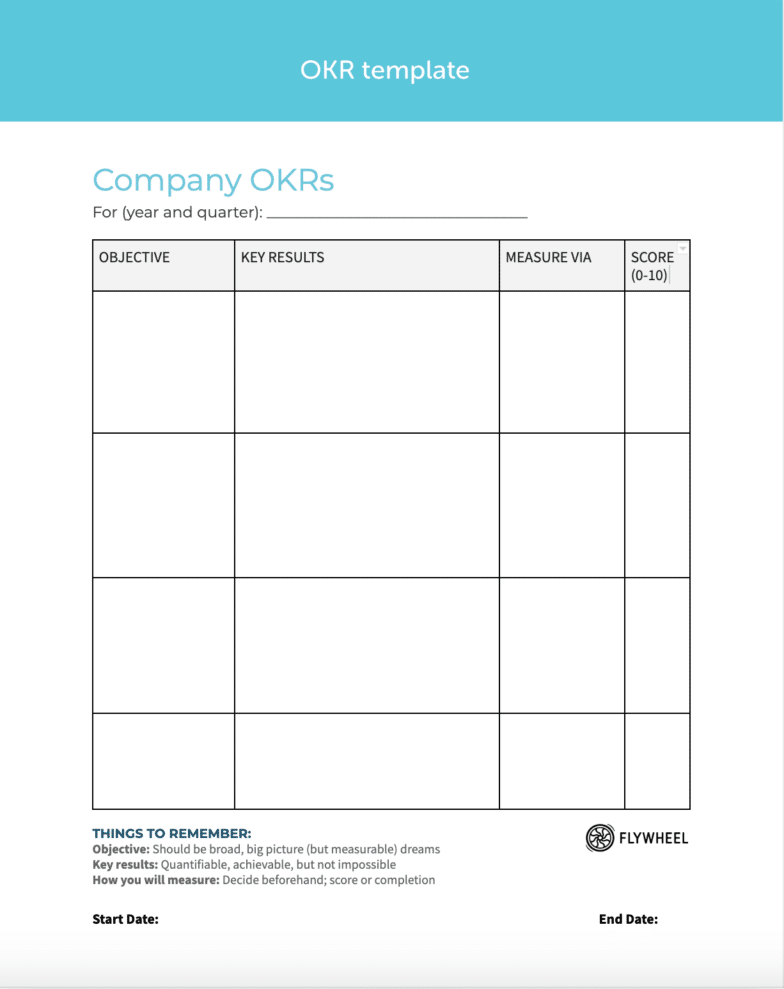
If you’re a business owner, you (hopefully) have a goal-setting system in place to ensure that your company’s major milestones are moving full-steam ahead. While every business is different in how they set goals, achieve them, and evaluate achievements, Flywheel has found some major success in creating and tracking OKRs, or objectives and key results.
Like a lot of things here at Flywheel, our process with OKRs has definitely been a work-in-progress. We first introduced the concept in 2017. We had big eyes on some big targets, and we maybe got a little carried away with the number of things we set out to achieve. The problem? We set a few too many, so the method wasn’t quite right for what we wanted to accomplish. We hit pause in 2018, reset our company’s goals and vision in 2019, and are now currently full steam ahead on crushing our company objectives for the year.

Now that we’ve had some practice, we’ve learned that OKRs help us clearly communicate and articulate our goals to the entire company, while simultaneously ensuring that every single Flywheeler has a role to play in achieving success!
What are OKRs?
Put simply, OKRs provide a company-level, department-level, and individual roadmap that ensures everyone is taking the same paths up the mountain. An OKR has two components — the objective sets the goal, while the key results tell us how we’re going to know we achieved it.
How to write objectives
Objectives should be high-level, qualitative statements, not tasks or granular outcomes. They should be significant to the company and meaningful/aspirational. They should also be aligned and supported by the entire organization.
Example: Put a person on the moon by the end of the decade.
Many objectives aren’t truly measurable, but can be phrased in a way that makes it clear what accomplishment looks like. Either an astronaut ends up on the moon or she doesn’t.
How to write key results
How do we measure progress toward a qualitative goal that is inherently immeasurable? We identify measurable outcomes that indicate we’ve achieved your objective.
For each objective, think about the results you would see (and can measure) if you reached it. Again, these are not supposed to be a glorified to-do list; they should be measurable results that, if achieved, drive us to succeed at our objective.
Key results should also describe outcomes rather than activities (“Increase SEO’s share of voice to 10 percent” instead of “improve our share of voice”). They should also be a mix of quantitative and qualitative, so you don’t incentivize the wrong things!
“When you work at Flywheel, no matter your role, you have an opportunity to understand your impact on a fast-growing startup company, every single day. Not that many companies can say that! OKRs are the way that every single person can understand their impact on the business, every single day.”
Karen Borchert, COO

Breaking down OKRs
Objectives should be high-level, qualitative statements that are aspirational – not tasks or granular outcomes.
Company OKRs
These are about as broad as you can imagine, like “launch a new product” or “increase revenue.” At our all-company retreat in January this year, our senior leaders announced four feasible objectives to the company. Flywheel will be:
- A multi-product company
- An unstoppable growth machine
- A smart and efficient business
- Built by skillful, engaged teams
These four objectives each came with three to four key results (and in typical Flywheel fashion, their very own logos!). But, Dusty and Karen didn’t just announce these OKRs and call it a day, we talk about them constantly.




We hold bi-weekly all-company meetings at 11:11 (it’s tradition), and we use this time to update the company on OKRs. These check-ins are much better than emails because we can celebrate wins (yay!) or dive into things that might be off track.
You can feel the energy shift after these meetings, as each team is excited to continue working on crushing our OKRs, which is where department OKRs come into play.
Department OKRs
The purpose of department OKRs is to essentially divide and conquer the main organization’s OKRs. Once the company outlined our four high-level OKRs for the year, we met as individual teams and created our own set of objectives and key results, like staying on track with our product roadmap and consistently hitting our lead generation model.
As an OKR owner, it is your role to guide the success of the KR and provide updates on a very regular cadence.
Jamie Bell, Director of Marketing
Typically, there is an assigned leader who’s responsible for that specific department OKR. The purpose? To make sure someone is accountable for the OKR moving along and not being forgotten about.
It’s important to note that anyone can own an objective or key result. While department heads do typically own objectives, we have plenty of individual contributors here at Flywheel who oversee key results.

Whitney, our Loyalty Strategist, is the owner of a Department OKR about product adoption
Individual OKRs
If you’re an objective owner for your department, it’s pretty clear what your personal key results should be. For example, if your objective is to hit the first page of Google, then your key results should reflect lots of keyword research and writing.

Not an owner of a specific OKR? That’s totally okay. You can still contribute by asking questions, spitballing an idea, or submitting a project!
Scoring OKRs
After working for weeks or months toward an objective, it’s time to give it a simple score between 0-10 (and we recommend you choose the number in under five minutes).
Why 0-10?
Having a scoring scale of 0-10 makes it fairly easy and straightforward to determine success. A score of zero would mean it was not at all achieved. A score of five would mean you met half the objective, or it’s just not complete in a way you thought it would be. A score of 10, while exciting, probably means you should set higher objectives next time!
OKRs are supposed to be “uncomfortable.” It’s GOOD if they make us nervous; that means we’re outside our comfort zone, which is the space where all awesome growth happens!
Jamie Bell, Director of Marketing
When setting objectives, you want to be intentional, but not unrealistic. You actually want to shoot for a six to seven range. Why? Because it’s high enough to where you were very close to achieving it, but just barely missed the mark.
Another way you can measure OKRs is by marking them completed or not completed. Let’s say you have an OKR of collecting missed payments from a large client. You can measure that by saying, “Yes, I completed that” or “No, I did not do that at all”.
Regardless if you use a scale of 0-10 or completed vs. not completed, the important part is evaluating fairly.
To be honest, we’re pretty hard on ourselves when it comes to scoring OKRs, but it’s because our company values taught us to be hungry and to constantly be a work-in-progress.

Why five minutes?
Essentially, you shouldn’t overthink the score too much. Give your team five minutes to read the data, analyze it quickly, set a score and, most importantly, stand by that score. Be proud of the work you did, whether you scored a two or a ten!
Don’t argue whether the score should be a five or six; the importance is determining as a team what your bar for success is.
As you can see, each and every person can play a pivotal role in total company success. Individual OKRs impact department OKRs which roll up to company OKRs!
How we use them to crush our goals
2019 marks Flywheel’s seventh year in business (and third year trying out OKRs). While we’re still young, we’re growing so rapidly that most people are debating whether or not to call us a startup anymore. With growth that fast, it’s imperative that we’re all on the same page, despite being in different offices, states, and countries!
We’re delighted to announce that we’re no. 344 on this year’s #Inc5000 list of fastest-growing companies in the nation! Read all about this extremely exciting news here: https://t.co/O9fSLb4tmE pic.twitter.com/RfmcNITxlT
— Flywheel (@HeyFlywheel) August 15, 2018
Without OKRs, it’d be simple for a company this large to lose track of the bigger picture, and that’s why they’re so important to us. We even use a template to make defining, tracking, and scoring OKRs super simple!
Conclusion
Whether you’re the owner of a small agency or a Fortune 500 company, OKRs can drastically impact your team’s focus and your company’s vision for the future. Focus on what you can do to drive progress towards OKRs in the moment, rather than thinking about it as this huge audacious goal over the course of the quarter.
Just remember that OKRs are a work-in-progress. Some days, you’re not going to move the needle at all, and that’s okay. But amidst and in between all of the meetings, emails, and focusing on the day-to-day grind of things, OKRs will show you where to focus, so that on the days where you can make considerable progress or you have ‘down time’, it’s alllll driving toward the right thing!

Ready to start setting (and achieving!) OKRs in your business or personal life? Download our free customized OKR templates with the button below!









Comments ( 3 )
Index Home
July 2, 2025
Thank you, your article surprised me, there is such an excellent point of view. Thank you for sharing, I learned a lot.
binance
March 5, 2025
Your article helped me a lot, is there any more related content? Thanks!
Tuan Anh
June 29, 2019
Great article ! Thank you, I learned a lot.